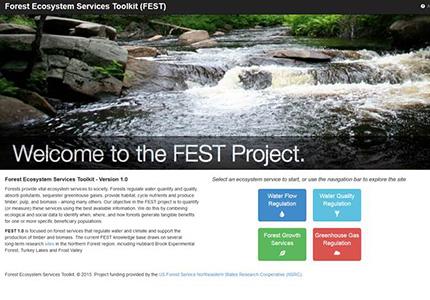Impacts of Forest Management on Regulating Services in Northern Forest Watersheds: Development of the Forest Ecosystem Services Toolkit

Forests and woodlands of the Northern Forest region provide society with a variety of important ecosystem services, including wood and other forest products, cultural activities, and regulation of the human environment. These services often go unmeasured. Drawing on a wealth of existing scientific data, NSRC researchers created the Forest Ecosystem Services Toolkit (FEST) to begin the process of quantifying and visualizing the capacity of forests to provide these services under real-world forest management treatments. The FEST methodology is based on estimating the ecological capacity of forests to provide potential services (i.e. “supply”) and the use or hypothetical use of those services by people (i.e. “demand”).
Researchers focused initial work on five ecosystem services: water flow regulation (flood regulation, drought mitigation), water quality regulation, forest growth regulation, greenhouse gas regulation, and provision of woody biomass for energy and products. They found a clear trade-off between timber harvesting intensity and the capacity of the forest to mitigate greenhouse gas emissions. In contrast, they found that regulation of water flow and water quality was relatively resilient in response to harvesting intensity.
With these results, FEST provides some initial estimates of the capacity of three sites (Hubbard Brook Experimental Forest in New Hampshire, Turkey Lakes Watershed in Ontario, and Neversink River Research Watershed in New York) to provide important ecosystem benefits to communities in the region. A survey of residents highlighted the importance of understanding and quantifying social demand for ecosystem services in order to better quantify how forests and our management choices affect human well-being in our local, regional, and global communities.
